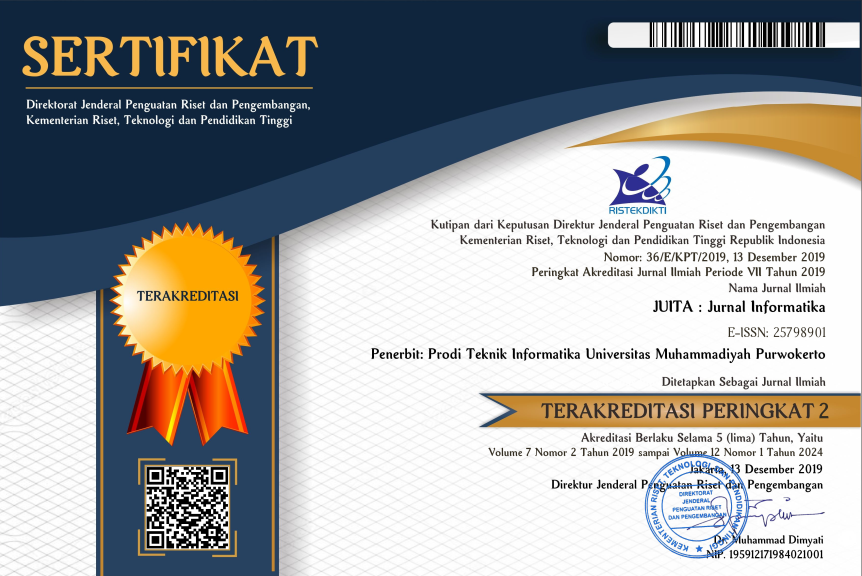Application of the Minkowski Distance Similarity Method in Case-Based Reasoning for Stroke Diagnosis
DOI:
https://doi.org/10.30595/juita.v11i2.18582Keywords:
Case-Based Reasoning, Stroke Diagnosis, Minkowski Distance similarityAbstract
A Stroke is a cerebrovascular disease characterized by impaired brain function due to damage or death of brain tissue caused by reduced or blocked blood and oxygen flow to the brain. Expert systems can be used as learning aids for medical students to diagnose stroke. Medical records of stroke cases can be reused as a reference for diagnosing stroke when there are new cases, known as the case-based reasoning (CBR) method. This study implements the Minkowski distance similarity method in CBR to calculate the similarity value between cases, where each similar case has the same solution. This study uses the Minkowski distance similarity method in CBR to obtain the most optimal value of r and the most appropriate threshold value in the expert system for stroke diagnosis. The diagnosis process is carried out by inputting the patient's condition, symptoms, and risk factors. Then the system will calculate the similarity value and take the case with the highest similarity value as the solution, providing that the similarity value must be greater than or equal to the threshold value. Based on system testing, the best accuracy value was achieved by applying a threshold value of 75 with an r value of 3 or 4, with an accuracy rate of 88,89%, a recall value of 88%, and a precision of 100%.References
[1] Kementerian Kesehatan, “Apa itu Stroke,” http://p2ptm.kemkes.go.id/infographic-p2ptm/stroke/apa-itu-stroke, 2018.
[2] P. J. F. Lucas and L. C. Van Der Gaag, Principles of expert systems. Singapore: Addison-Wesley Publishing, 1991. [Online]. Available: https://www.researchgate.net/publication/220694050
[3] R. Rizky, A. H. Wibowo, Z. Hakim, and L. Sujai, “Sistem Pakar Diagnosis Kerusakan Jaringan Local Area Network (LAN) Menggunakan Metode Forward Chaining,” J. Tek. Inform. UNIS, vol. 7, no. 2, pp. 145–152, 2020, doi: 10.33592/jutis.v7i2.396.
[4] A. Abraham, “Rule-based Expert Systems,” in Handbook of Measuring System Design, P. H. Sydenham and R. Thorn, Eds. John Wiley & Sons, Ltd., 2005, pp. 909–919.
[5] A. Gunawan, C. Suhery, and T. Rismawan, “Implementasi Metode Case-Based Reasoning Dan Similarity Jaccard Coefficient Dalam Identfikasi Kerusakan Laptop,” J. Komput. dan Apl., vol. 09, pp. 292–305, 2021.
[6] H. Henderi, F. Al Khudhorie, G. Maulani, S. Millah, and V. T. Devana, “A Proposed Model Expert System for Disease Diagnosis in Children to Make Decisions in First Aid,” INTENSIF J. Ilm. Penelit. dan Penerapan Teknol. Sist. Inf., vol. 6, no. 2, pp. 139–149, 2022, doi: 10.29407/intensif.v6i2.16912.
[7] B. Basiroh and S. W. Kareem, “Analysis of Expert System for Early Diagnosis of Disorders During Pregnancy Using the Forward Chaining Method,” Int. J. Artif. Intell. Res., vol. 5, no. 1, pp. 44–52, 2021, doi: 10.29099/ijair.v5i1.203.
[8] X. Huang et al., “A Generic Knowledge Based Medical Diagnosis Expert System,” ACM Int. Conf. Proceeding Ser., vol. 1, no. 1, pp. 462–466, 2021, doi: 10.1145/3487664.3487728.
[9] I. Setiawan and M. Batara, “Expert System Design to Diagnose Pests and Diseases on Local Red Onion Palu Using Bayesian Method,” BAREKENG J. Math. Its Appl., vol. 17, no. 1, pp. 371–382, 2023.
[10] M. M. Richter and R. O. Weber, Case-Based Reasoning. New York: Springer Berlin Heidelberg, 2013. doi: 10.1007/978-3-642-40167-1.
[11] I. Nugraha and M. Siddik, “Penerapan Metode Case Based Reasoning (CBR) Dalam Sistem Pakar Untuk Menentukan Diagnosa Penyakit Pada Tanaman Hidroponik,” J. Mhs. Apl. Teknol. Komput. dan Inf., vol. 2, no. 2, pp. 91–96, 2020, [Online]. Available: https://www.ejournal.pelitaindonesia.ac.id/JMApTeKsi/index.php/JOM/article/view/575/387
[12] I. Y. Subbotin and M. G. Voskoglou, “Applications of fuzzy logic to Case-Based Reasoning,” vol. 11, pp. 7–18, 2012, [Online]. Available: https://www.researchgate.net/publication/223129950
[13] A. S. Soroto, A. Fuad, S. Lutfi, J. J. Metro, and K. T. Selatan, “Penerapan Metode Case Based Reasoning (CBR) untuk Sistem Penentuan Status Gunung Gamalama,” J. Inform. dan Komput., vol. 02, no. 2, pp. 70–75, 2018.
[14] A. Yuli Vandika and A. Cucus, “Sistem Deteksi Awal Penyakit TBC dengan Metode CBR,” Pros. Semin. Nas. Darmajaya, 2017.
[15] M. Nishom, “Perbandingan Akurasi Euclidean Distance, Minkowski Distance, dan Manhattan Distance pada Algoritma K-Means Clustering berbasis Chi-Square,” J. Inform. J. Pengemb. IT, vol. 4, no. 1, pp. 20–24, 2019, doi: 10.30591/jpit.v4i1.1253.
[16] R. Nelson, A. Harjoko, and A. Musdholifah, “Case-Based Reasoning for Stroke Disease Diagnosis,” IJCCS (Indonesian J. Comput. Cybern. Syst., vol. 12, no. 1, p. 33, 2018, doi: 10.22146/ijccs.26331.
[17] M. Zainuddin, K. Hidjah, and W. Tunjung, “Penarapan Case-Based Reasoining (CBR) untuk Mendiagnosis Penyakit Stroke Menggunakan Algoritma K-Nearest Neighbor,” CITISEE, 2016.
[18] I. Warman, “Sistem Pakar Identifikasi Penyakit Tanaman Padi Menggunakan Case-Based Reasoning,” 2017.
[19] R. Adawiyah, “Implementasi Metode Minkowsky Distance untuk Deteksi Kelahiran Bayi Prematur Berbasis Case-Based Reasoning,” J. Inform. dan Komputer) Akreditasi KEMENRISTEKDIKTI, vol. 3, no. 1, 2020, doi: 10.33387/jiko.
[20] A. Mubarak, M. Salmin, A. Fuad, and S. Do Abdullah, “Penalaran Berbasis Kasus Untuk Diagnosis Penyakit Malaria Dengan Menggunakan Metode Minkowsky Distance,” J. Ilm. Ilk. - Ilmu Komput. Inform., vol. 5, no. 1, 2022, doi: 10.47324/ilkominfo.v4i3.136.
[21] A. Labellapansa, A. Efendi, A. Yulianti, and A. K. Evizal, “Lambda value analysis on Weighted Minkowski distance model in CBR of Schizophrenia type diagnosis,” in 2016 4th International Conference on Information and Communication Technology, ICoICT 2016, 2016, vol. 4, pp. 1–4. doi: 10.1109/ICoICT.2016.7571898.
[22] E. Faizal and H. Hamdani, “Weighted Minkowski Similarity Method with CBR for Diagnosing Cardiovascular Disease,” Int. J. Adv. Comput. Sci. Appl., vol. 9, no. 12, 2018, doi: 10.14569/IJACSA.2018.091244.
[23] E. Wahyudi and N. I. Pradasari, “Case Based Reasoning untuk Diagnosis Penyakit Jantung Menggunakan Metode Minkowski Distance,” INTECOMS J. Inf. Technol. Comput. Sci., vol. 1, no. 1, pp. 119–123, 2018, doi: 10.31539/intecoms.v1i1.170.
[24] “Stroke Symptoms,” American Stroke Association, 2021. https://www.stroke.org/en/about-stroke/stroke-symptoms
[25] M. K. Jha, D. Pakhira, and B. Chakraborty, “Diabetes Detection and Care Applying CBR Techniques ,” IJSCE, vol. 2, no. 6, 2013.
[26] D. Normawati and S. A. Prayogi, “Implementasi Naïve Bayes Classifier Dan Confusion Matrix Pada Analisis Sentimen Berbasis Teks Pada Twitter,” 2021.
Downloads
Published
How to Cite
Issue
Section
License

JUITA: Jurnal Informatika is licensed under a Creative Commons Attribution 4.0 International License.
















